When playing in a Magic: The Gathering format where decks are typically built around a legendary creature, it isn’t exactly a revelation to point out that you should include the ability to answer said creatures while building your Commander deck.
Spot removal, or spells that destroy a single creature, can definitely get the job done for a low mana cost, but when you have approximately 3 opponents to worry about simultaneously, it is likely to come up short as creatures start to pile up on the battlefield.
In these cases, you need access to spells that can remove lots of creatures at once, often referred to as board wipes. Fortunately, as a color known for achieving its goals by any means necessary, black has an excellent pool of these cards to draw from.
How Do Black’s Best Mass Removal Spells Work?
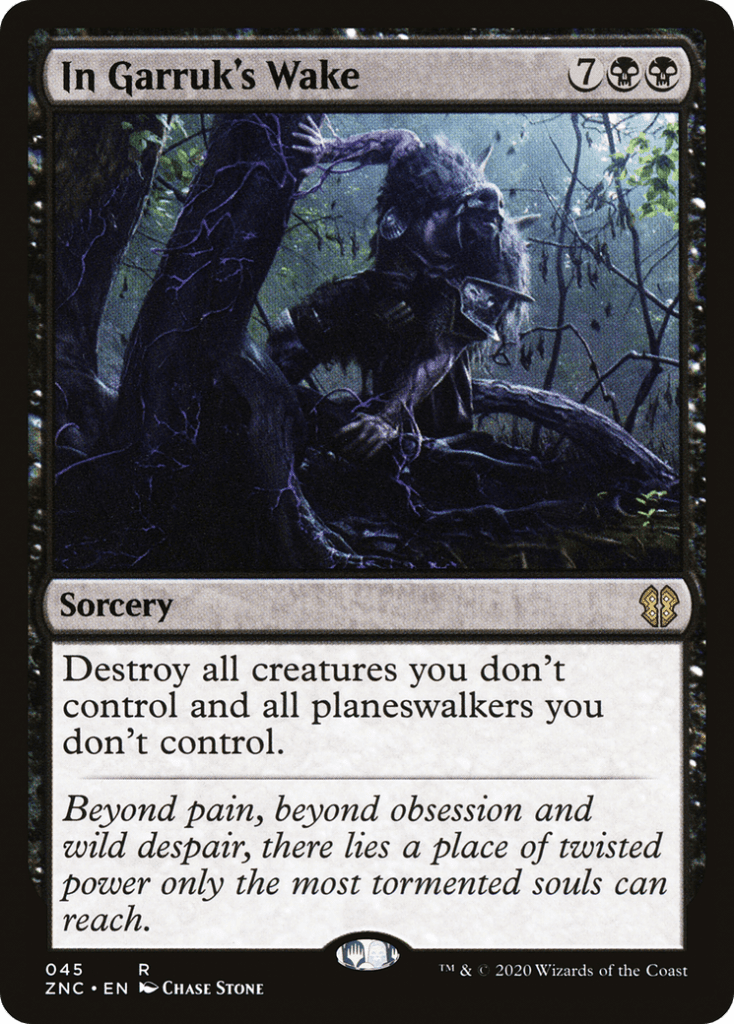
Black, as a color pie identity, isn’t afraid to kill to get what it wants. This shows up on its board wipes by offering several efficient methods of killing creatures and planeswalkers, including outright destruction, exile effects, and reducing toughness or loyalty to 0.
While pain and death are useful tools for motivating the living, you can’t coerce inanimate objects or raw magic, meaning that black has no recourse for dealing with artifacts and enchantments en masse without enlisting the aid of another color or a colorless card.
It’s also quite rare to even find spot removal for these types of permanents, creating a serious blind spot for mono black builds that can be a real struggle to overcome. That said, if you can still reduce your opponents’ life totals to zero, the pain you’ll have to endure from these types of cards is simply the price of doing business.
As with other board wipe articles, specific types of board wipes will be grouped together and individual entries will be loosely ranked from worst to best. There are also many other board wipes beyond those in this post that are well suited for specific strategies.
Don’t be afraid to use all the resources at your disposal, including Gatherer and Scryfall, to find the best tools for your needs.
Tribal Board Wipes (Extinction, Kindred Dominance, Olivia’s Wrath, Tsabo’s Decree)
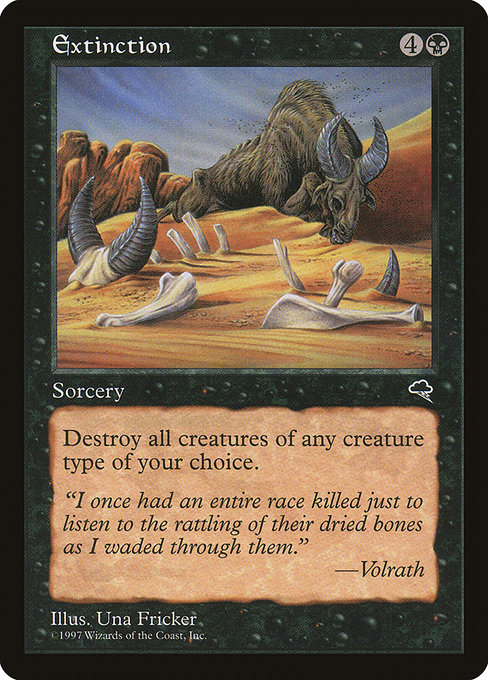
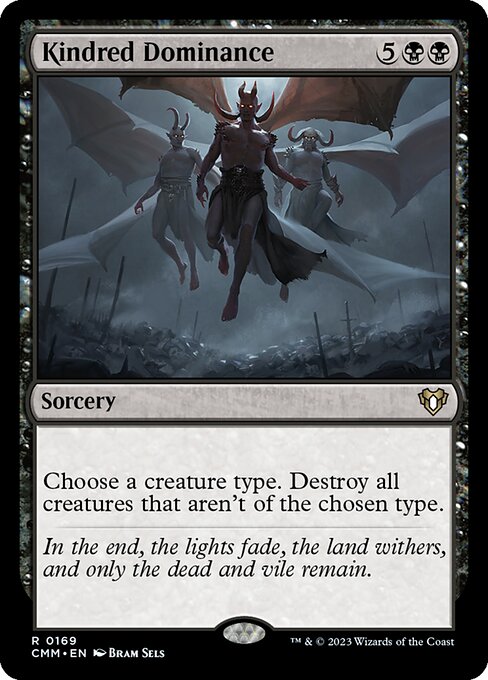
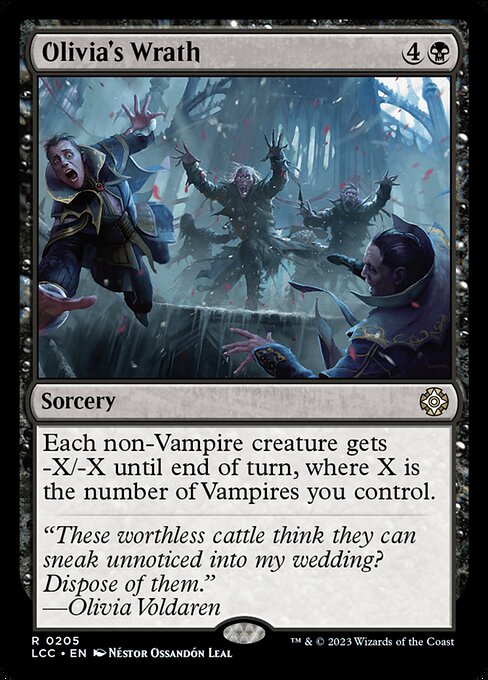
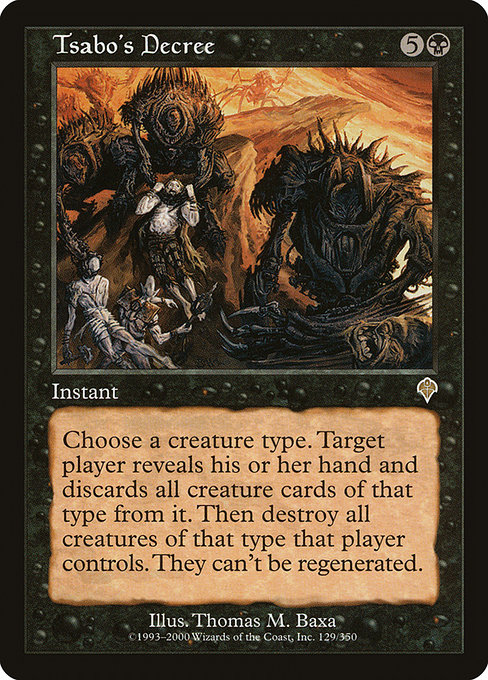
Tribal board wipes can behave a few different ways in black. Some, like Extinction and Tsabo’s Decree can eliminate any creature type of your choice, with Tsabo’s Decree going the extra mile and forcing a player to discard all creatures of the chosen type from their hand.
Others, like Olivia’s Wrath and Kindred Dominance, focus on preserving a specific creature type at the expense of all others. These types of tribal board wipes are intended to be one-sided without forcing you to pay 9 mana for more blatant versions of the same effect like Plague Wind or In Garruk’s Wake, making it far more likely you can cast them when needed.
Finally, there are also tribal board wipes that go after specific tribes, such as Zombie Apocalypse. While this card is incredibly good in a dedicated Zombie deck, in most cases you’re better off playing a board wipe that gives you more control over what you destroy like Extinction if you really need a silver bullet against tribal decks, as it can act as spot removal in a pinch.
Color Hosers (Nature’s Ruin, Spreading Plague, Stench of Evil, Virtue’s Ruin)
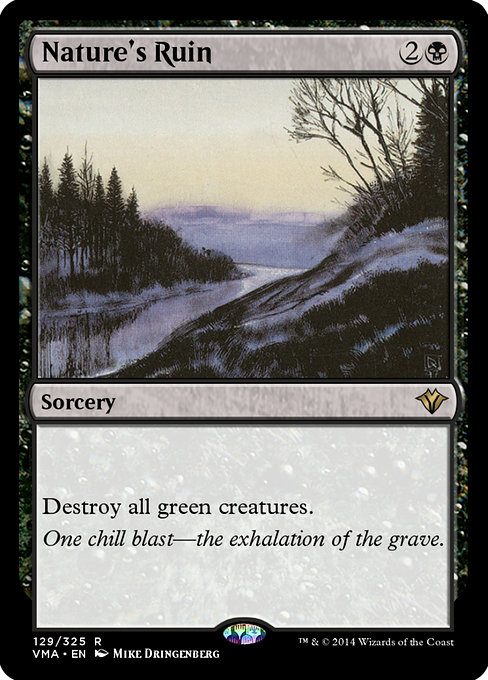
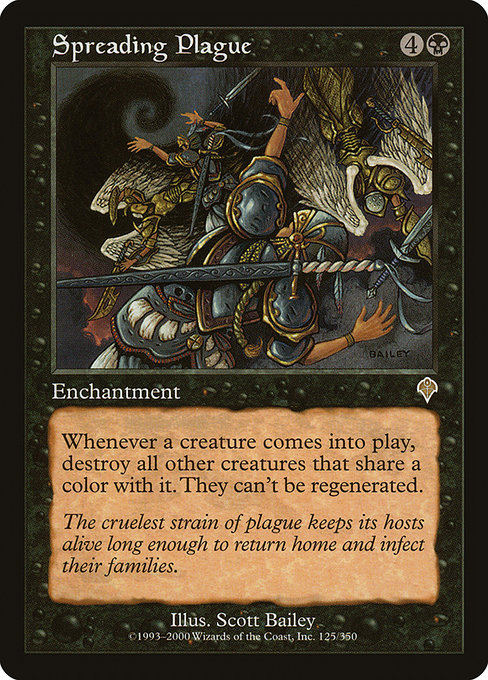
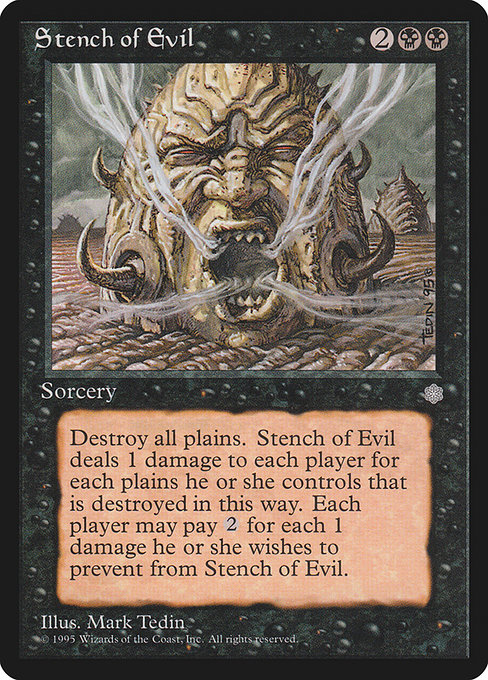
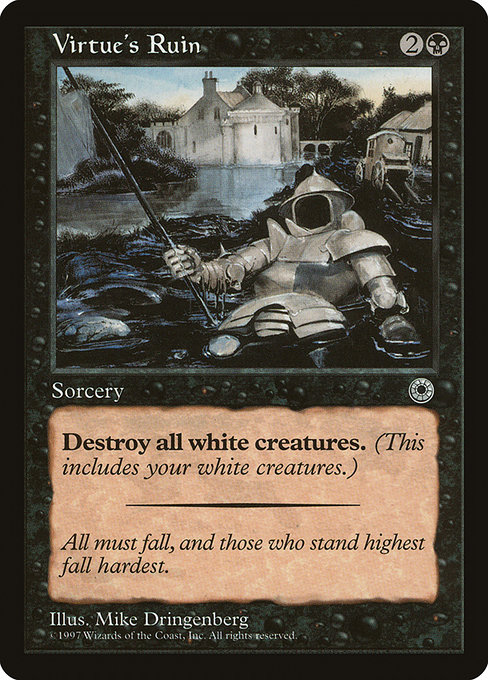
Black’s natural enemies in the color pie are green and white, and it has several brutally efficient answers for shutting them down. Nature’s Ruin and Perish can clear all the big, high power creatures green has to offer for a mere 3 mana, and Virtue’s Ruin is perfectly equipped to do the same to white.
Spreading Plague offers a different interpretation of these effects, serving as a rattlesnake that discourages players from building up their existing board states. Once every creature turns into a color hoser, it’s only a matter of time before the board state will reduce itself down to a handful of creatures, keeping aggressive decks in check for as long as this nasty enchantment remains in play.
Stench of Evil has the distinction of being black’s only mass land destruction spell that doesn’t require other colors, but if you’re playing against a mono white deck, it’s a doozy. Destroying all plains is already a potent effect, but inflicting a point of damage to their owners for each one destroyed can add up pretty quickly, especially in the late game when life totals are low.
Planeswalker Board Wipes (Aether Snap, The Elderspell)
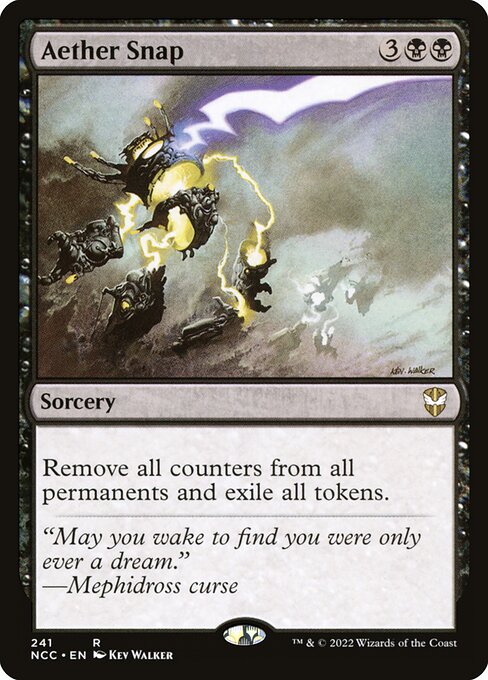
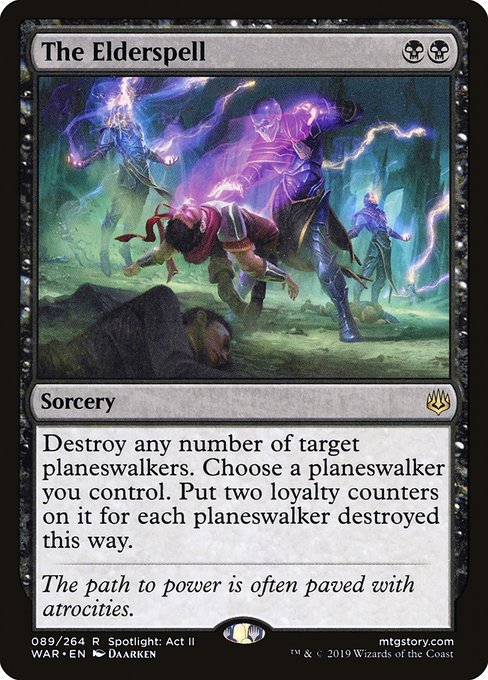
It’s kind of weird that the first board wipe for planeswalkers actually predates their premier in Lorwyn, but Aether Snap‘s ability to answer +1/+1 and charge counters during Mirrodin block translated perfectly to the design space occupied by Magic’s newest permanent type.
Outside of Superfriends decks (decks that revolve around planeswalkers), you don’t really see a lot of planeswalkers in Commander due to their overall fragility, which makes Aether Snap more likely to see play as a silver bullet against token decks instead.
If a Superfriends deck is causing problems in your meta, however, you can really stick it to them with a copy of The Elderspell. Designed as an extremely efficient answer for Standard in the event planeswalkers started running the format after War of the Spark, no planeswalker board wipe has been as destructive or cost-effective before or since its printing.
Hellfire

There’s something about lopsided board wipes that makes you feel like you’re taking charge in Commander, and if you get burned a little when throwing Hellfire at your enemies, well, sometimes them’s the breaks.
Sure, 5 mana isn’t an amazing rate for a board wipe, but it is definitely still acceptable for most Commander decks outside of cEDH. In exchange for this slightly more costly spell, you’re allowed to keep most or all of your creatures alive while removing multiple threats, which can be absolutely backbreaking on a previously deadlocked board state.
The catch? You’ve got to have enough life to survive casting this spell.
Timing is crucial for harnessing Hellfire‘s power, as there’s a very good chance of losing at least 10-15 life in a 4-person pod when casting it during the middle or late stages of a Commander game. While that isn’t an unreasonable cost when you start at 40 life, it’s still a sizable percentage of your life total and should respected as such.
Additionally, opponents also playing black creatures aren’t going to be affected as much, if at all. While this can ease the burden of life loss, it does also mean you won’t have a strictly open field to work with after resolution, meaning you’ll either need to cut a deal or avoid swinging all out at those you just rendered defenseless.
And don’t even bother with Hellfire if you’re playing against tokens. You’re just going to take too much damage from this spell in that matchup.
Nightmare Unmaking
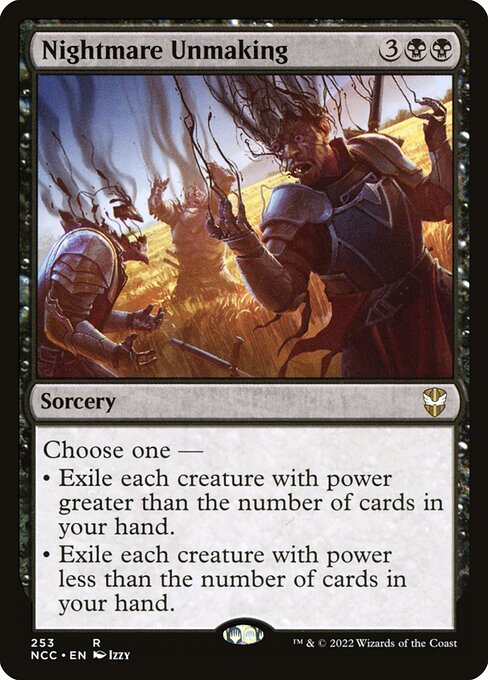
Nightmare Unmaking is an interesting 5 mana board wipe I overlooked during its debut in Commander 2019, but it is a surprisingly malleable card that can be crafted to address a lot of different board states. I also appreciate that it exiles, as that makes this card very useful against indestructible titans like Avacyn, Angel of Hope or Ulamog, the Infinite Gyre.
When you need to deal with as many creatures on the battlefield as possible, you can either play a few cards to lower the number of cards in your hand or draw several more using a spell like Promise of Power, depending on what all is on the battlefield.
If you have the biggest creature(s) in play and need to clear the chump blockers out, just make sure you have enough cards in hand to clear the weaklings out. In the event that you’re the one staring down big threats with smaller creatures, keep enough cards to shield them and permanently dispatch all your problems in one fell swoop.
One final thing to note: Nightmare Unmaking specifically hits creatures with power greater than or less than the number of cards in your hand. Never equal to. This makes the order in which you play your cards during your turn absolutely critical, so take a moment to plan out your turn and decide on what needs to be exiled before simply throwing this card on the table.
Mutilate
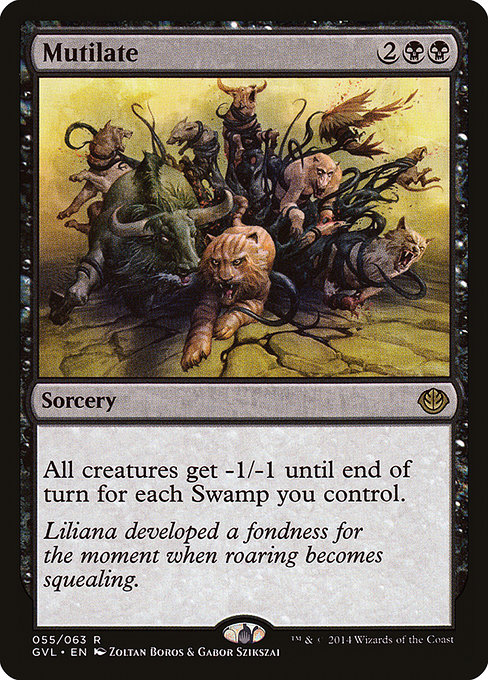
Mutilate is a great 4 mana board wipe for mono color decks that are looking for answers to indestructible creatures and big board states alike. Giving all creatures -1/-1 for each of your Swamps will usually ensure you’re able to successfully kill off all creatures as long as you don’t miss a lot of land drops or play too many nonbasic lands.
For multicolor decks or black decks that really like their nonbasics, you can usually work around Mutilate‘s requirement with the aid of Urborg, Tomb of Yawgmoth, a legendary land that makes all lands Swamps in addition to their other types. It’s commonly played by most black decks for color fixing or to combo with Cabal Coffers anyway, so there’s no real deckbuilding cost for playing it.
Plus, if you get lucky, an opponent might play theirs early so you don’t have to look for yours!
If you don’t play a lot of Swamps (basic or nonbasic) in your deck, however, Mutilate can easily become very underwhelming. -2/-2 or -3/-3 just isn’t enough to deal with a lot of commonly played creatures in Commander, so it’s important to have reliable ways to bring this card online (read: tutor for Urborg) in a pinch should you need to do so.
Phyrexian Scriptures
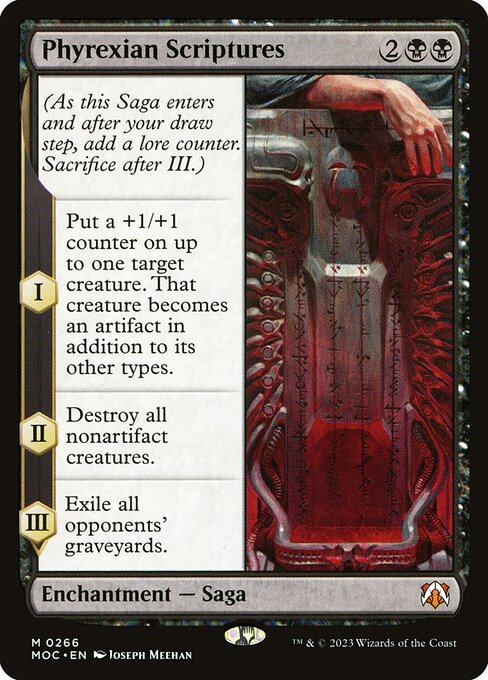
Phyrexian Scriptures is kind of the perfect board wipe to represent how I play Commander. Over the course of 2 turns it wipes the board, saves your best creature from being destroyed, then finishes out by exiling all opposing graveyards, exiling the threats you just destroyed while leaving your graveyard intact for future recursion.
While I’ve had a lot of success playing this card, there are a couple major downsides that have kept it out of many decks. First, since Phyrexian Scriptures is a Saga, it can be hit by removal before reaching its second chapter, meaning you paid 4 mana just to put a single +1/+1 counter on a creature. Not great, to say the least.
Second, while you’re protecting your best creature from Phyrexian Scriptures by making it an artifact, you’re also making it more vulnerable by introducing a weakness to artifact removal like Vandalblast, Cleansing Nova, or Reclamation Sage.
These and other artifact removal spells see a fair bit of Commander play, so you often aren’t buying the creature you’re attempting to protect much time, if any at all. Sure, you could attempt to mitigate this problem by playing a card like Darksteel Plate, but then you’re defeating the purpose of your Saga’s first chapter and waiting a turn to wipe the board for no reason.
At that point, you might as well play a different board wipe that has an immediate impact instead.
The Meathook Massacre

The Meathook Massacre reminds me a lot of Massacre Wurm, a creature that saw an absolute ton of Commander play years ago. When it enters the battlefield, you give all creatures -X/-X until the end of the turn, depending upon how much mana you put into it. Your opponents will usually lose a little life when your creatures die, and you’ll gain a sizable amount for theirs dying.
After the board is wiped, you’re left with an enchantment that will continue to punish your opponents in the same ways when creatures are killed off. While this doesn’t seem like much on an empty board, Aristocrats strategies (decks that inflict incremental damage to opponents by sacrificing cheap or token creatures) can do a lot of damage with this effect if left unchecked.
Lifegain decks like Karlov of the Ghost Council are also able to benefit a lot from The Meathook Massacre‘s presence, as you can quickly build up an impressive life total to shrug off attacks, pay for certain spells, or simply create a deadly creature that can win through commander damage or by repeatedly exiling dangerous opposing creatures.
Torment of Hailfire

Once you’ve had a chance to build up your mana in the late game, Torment of Hailfire is such a brutal board wipe it also acts as a finisher. At first glance, it looks like it’s giving your opponents reasonable options – they can either sacrifice a nonland permanent, discard a card, or lose 3 life, but they must do so X times.
This illusion of choice quickly falls apart if you’re short on 1 or more of these axes. If you don’t have much life to spare, permanents and cards in your hand become very expendable, leaving you relatively defenseless. If you’re short on cards, you’re probably losing most or all of your remaining life if X is at least 7, and with Cabal Coffers, that isn’t hard to achieve.
The only real drawback to running Torment of Hailfire is that it isn’t all that useful in the early or mid game because life totals are likely to be high. Sure, taking 15 life from every opponent is a good use of 7 mana, but when you start at 40 and aren’t impacting the board at the same time, all you’re really doing is giving the table an excuse to come after you.
Extinction Event

You don’t see a lot of 4 mana board wipes that exile in Magic, and while Extinction Event isn’t going to deal with every creature in play, the choices it offers you provide much more finesse than the traditional sledgehammer approach of clearing the whole board.
Simply choose odd or even, then watch as Extinction Event erases the existence of all creatures with matching mana values, even if they’re shrouded, hexproofed, and/or indestructible. Perfect for ensuring they aren’t coming back via cards like Eternal Witness or Animate Dead, and sometimes you can even do so without impacting your own board!
Speaking of one-sided possibilities, Extinction Event also has the distinction of being situationally good when you’re ahead. If your best creatures all share even or odd mana costs, clearing away chump blockers and modest threats with one spell is a great way to tighten your stranglehold on a game, ensuring a lethal attack is more likely to go through than not.
Extinction Event‘s flexibility comes at a cost, however. While there are situations where you will benefit from a selective culling of the board, you will also come across moments where you need to nuke all creatures and won’t be able to with this card. I’ve found that the good opportunities far outnumber the bad in most decks, but when this card is bad, it’s really bad.
Damnation

A black Wrath of God was majorly exciting when Damnation debuted in Planar Chaos, and it has been a reliable workhorse in my black Commander decks since I started playing the format in 2008.
While not quite the staple it has been in years past, there aren’t many mono black cards that combine reliability, straightforward mass creature destruction, and a low mana cost into one convenient package. I’ve had games where Damnation was the epic topdeck I needed to mount a comeback, and others where it has gathered dust in my hand as a backup plan if someone sets me back.
Never once have I been unhappy to see it though. The day it retires from my decks after being fully outclassed by stronger, more efficient cards will be a sad one.
Dead of Winter
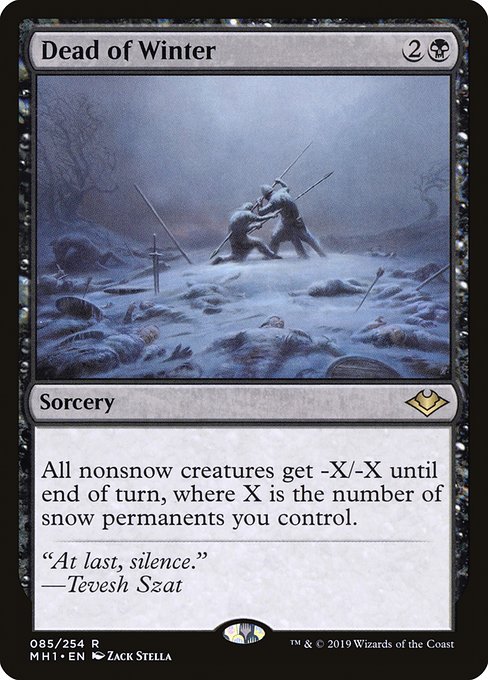
3 mana board wipes are usually absurdly powerful if they can clear creatures with any sort of efficiency, and since snow basic lands are snow permanents and reducing a creature’s toughness to 0 will kill anything indestructible, Dead of Winter clears that bar with ease.
Thanks to Kaldheim, we even have snow duals with basic land types these days, making it easier than ever for decks to get several snow permanents into play through fetchlands like Polluted Delta or mana ramp spells like Three Visits, setting you up to fix your mana and make big plays while also providing a way to efficiently erase those of your opponents.
Naturally, this means the deckbuilding cost to play Dead of Winter is actually very low for many black decks, and will likely get lower as more snow cards make their way into print. If you happen to be playing snow creatures to further take advantage of this card’s board clearing aptitude, that’s just icing on the cake.
Toxic Deluge
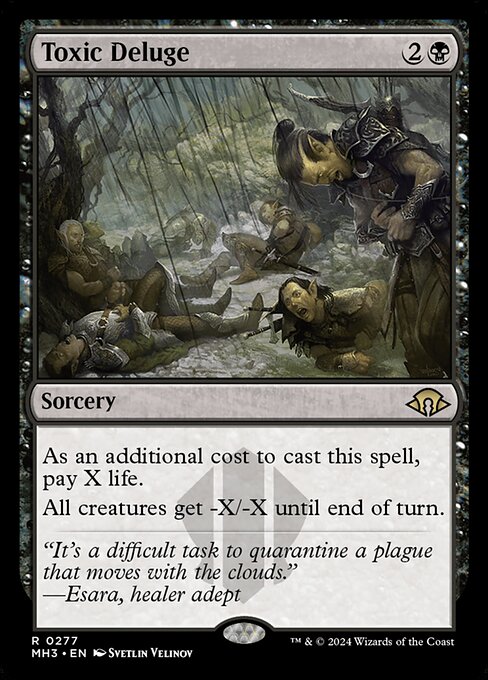
While True-Name Nemesis was garnering the most press out of all the new cards in Commander 2013 due to its low supply and instant superstar status in Legacy, Toxic Deluge was still a pretty expensive card on release at $15, and despite multiple reprints, frequently finds itself around or above that price point in the present day.
It isn’t exactly difficult to see why either. A 3 mana board wipe that gives all creatures -X/-X (allowing it to kill indestructible threats) that scales based on the amount of life you pay (instead of mana) in a format where you start with 40 is unbelievably useful.
This is the best generic black board wipe, and has been for a decade without terribly much competition. The only times it isn’t great are when you’re running low on life or already winning, but it more than makes up for that by being the most efficient answer to creatures at any other time.
Plus, in those cases where you really want to bow out of a Commander game without conceding, you can simply pay all your life and leave your opponents to pick up the pieces as you pack up. Or force an opponent to do so after using Mindslaver on them.
How Many Board Wipes Should Go in My Commander Deck?
While there isn’t going to be a perfect answer for every deck or metagame, I’ve found that playing 4-6 is usually a good starting point. If your Commander deck plays 25-30 creatures, you’ll probably be on the lower side of that. For decks that run a skeleton crew in terms of creature count, you might end up wanting a few more to protect your life total.
Toxic Deluge and Damnation are usually my first go-tos when building a black deck in Commander, as they are efficient and don’t require you to jump through any hoops. From there, I’ll pick at least a couple more in my colors that are tailored to the types of cards I want to try and keep in play and the threats I expect to need answers for in my local playgroups.
From there, the best way to see which board wipes work best is to jam some games, see what situations come up in gameplay, and adjust accordingly!
Other MTG Articles You Might Enjoy
- Best White Board Wipes for EDH
- MTG EDH Token Deck Commanders
- EDH Black Tutor Cards
- Best Mana Ramp Cards for Green EDH Decks
- Best EDH Dual Lands
- Spelltable Setup Guide
Braden is a founder of Assorted Meeples and has been a gamer & writer with a vivid imagination all his life. Don’t believe us? Check out his excitement when meeting Goosebumps author R.L. Stine as a kid! An avid Magic: The Gathering spellslinger for over 15 years, you can always convince him to shuffle up for a game (or three!) of Commander.
